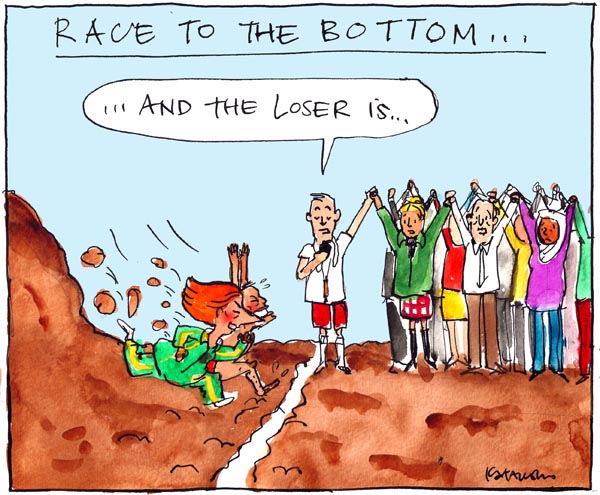Scene One:
The designer scrolls through to the sidebar widget. He doesn’t like it. He tests it: fully functional. He tweaks the color, adjusts the width, and he ultimately comes to the conclusion it is “pretty good.”
He’s not charging premium prices and he only knows how to do so much. He’s his own engineer and there is more work to be done. His skill and his resources are finite. He’s satisfied so he moves to the next task after 30 minutes of fidgeting.
Scene Two:
The exact same sidebar, the exact same functional pieces in place, but a different designer. This one comes to the conclusion “pretty good” isn’t good enough for him.
He continues to try new ideas, not just recycled ones he’s tried before. He gets out of his comfort zone and asks his engineers what else is possible. He plays with the idea of eliminating the sidebar altogether and going for a minimalist look. He does research on other sites for inspiration. Ultimately, after 2 hours, he decides it is better than “pretty good.” It is ready to ship.
Naturally, the second designer produces a better sidebar. The first delivers a functional product that gets the job done, but it’s not quite a pretty or smooth as the second.
More Time = Better Work… Right?
Nope, not necessarily. The amateur (scene one in case you didn’t pick up on that) spent less time on the sidebar, that is correct. But time wasn’t what made the difference in the end. It was the commitment by the artisan (scene two) to deliver a great product.
When artisans were members of guilds and trade organizations, they worked with the accumulated knowledge of hundreds of years of experience. It wasn’t just what they picked up in a YouTube video over the weekend.
They knew their finished product was not only a reflection of them, but of the their teachers and their teachers’ teachers.
The artisan can do more in a shorter period of time. In other words, he can do more with less. Their 30 minutes versus the amateur’s 30 minutes will be different, but that’s because one starts with a higher bar and he knows the standards he must meet.
The artisan can do more with 30 minutes, but that doesn’t mean he’ll be satisfied in 30 minutes. His standards are high, so it’s his commitment to excellence and his eye for what actually looks good that separates him from the amateur. Sure, he spent more time on the project. But that was the effect, not the cause of the difference in quality.
Is It Worth It?
This example comes from real life observations. I am the amateur and I can get most of the websites I create to a “good enough” place in a relatively short period of time. I’ll never be an artisan for the web design trade. However, I work with guys who are true artisans at SOUTH.
That’s not me and it never will be. Not because I don’t want it to be, but because I’ll never even try to pursue it.
As many of you know, I’m a big Tim Ferriss fan. He’s a huge advocate of learning, but learning with shortcuts so to speak. He looks for 20% of the actions that produce 80% of the results. Pareto’s Principle is the common name for this, and I’ve become a subscriber to this theory as well.
I’ll rarely spend hours and hours on a single sidebar. For the most part, I can get an item on a website 80% of where I want it to be in a few minutes. The more time I spend, the less significant the changes become. And if I can get it to “good enough” for the client, I can ship it faster. They are not expecting the highest quality design out of my work, they are expecting good enough, and that’s what I am able to deliver.
I get 80% of my design finished quickly. “Good enough” is in fact good enough for my personal clients that need their websites redone. They don’t want to pay top dollar for a website, they just want something functional that conveys a professional layout for current and potential customers.
The Race To The Bottom
Seth Godin, another of my favorite influencers, is always talking about the race to the bottom: i.e. lowest price wins model.
“But the problem with the race to the bottom is that you might win. You might make a few more bucks for now, but not for long and not with pride. Someone will always find a way to be cheaper or more brutal than you.”
During my marketing classes in school, there were always different business models we would discuss. One was the lowest price model, cheap & fast. Another was the differentiation model, the niche market. And the other other was the quality model, top dollar for the finest work.
But I think there’s a fourth category: the value category. It’s not necessarily different than anything else, so it’s not a niche. It’s not the lowest price around, but it’s not the most expensive, either. It is priced somewhere on the lower end of the pack and the price doesn’t necessarily reflect the value gained.
In other words, it’s a bargain.
Many small business owners value value, not a cheap price. They want something done right, but they don’t typically need a lot of bells and whistles or an innovative idea. They know if they pay bottom dollar, they will have to dump money into it again soon, costing even more in the long run.
This value is what I deliver when it comes to the field in which I freelance, web design. This isn’t my first rodeo, but I’m not going to deliver a site that a multi-national conglomerate would stand by, either.
Some companies need all of that and more, which is where SOUTH comes in. They (by they, I mean we) work on multi-million and multi-billion dollar companies’ sites. These organizations need new ideas as well as the most impressive designs available, so they’re willing to pay top dollar for an artisan to build it.
Who Will Survive? Who Will Thrive?
Companies that offer top quality will always have a place in the market. Their services will always be needed because some people will never compromise on their quality. Seth prefers the race to the top:
“The race to the top is focused on design and respect and dignity and guts and innovation and sustainability and yes, generosity when it might be easier to be selfish. It’s also risky, filled with difficult technical and emotional hurdles, and requires patience and effort and insight. The race to the top is the long-term path with the desirable outcome.”
Companies that offer value will also thrive in tomorrow’s economy. Not everyone can afford to pay top dollar, which is why there will always be a need for the bargain. The amateurs that grow businesses based on relationships, delivering value, and fair pricing will always carve out a place for themselves.
The ‘loser’ in the race to the bottom? Well they’ll always hang around, continuing to lengthen the price scale downward. I don’t think they’ll ever go away. But that’s not necessarily a bad thing. The more that guy puts out low quality work, the more appealing the artisan – and even the amateur – becomes to potential client.
How do you grow your business?
Leave me a comment or chat with me on Twitter, I’d love to hear from you. Have a great rest of the week!
—



